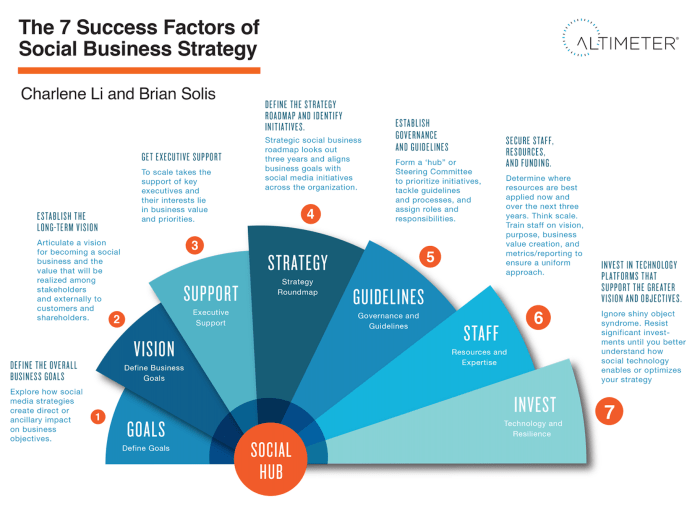Building a Social Media Strategy sets the stage for businesses to thrive in the digital landscape, paving the way for connection, engagement, and growth. Get ready to dive into the world of social media strategies that will revolutionize your online presence.
In today’s fast-paced digital world, having a solid social media strategy is crucial for businesses looking to make a mark in the online realm. From defining goals to creating engaging content, this guide will walk you through every step of the process.
Introduction to Building a Social Media Strategy

A social media strategy is a plan of action that Artikels how a business will use social media platforms to achieve its marketing and business goals. It is essential for businesses to have a well-defined social media strategy in place to effectively engage with their target audience, build brand awareness, drive website traffic, and ultimately increase sales and revenue.
Having a well-thought-out social media strategy can provide numerous benefits for businesses, including:
Increased Brand Awareness, Building a Social Media Strategy
- By consistently posting relevant and engaging content on social media platforms, businesses can increase their brand visibility and reach a larger audience.
- Interacting with followers through comments, likes, and shares can help humanize the brand and build stronger relationships with customers.
Improved Customer Engagement
- Responding to customer inquiries and feedback in a timely manner can help businesses build trust and loyalty among their audience.
- Running polls, contests, and surveys can encourage active participation from followers and create a sense of community around the brand.
Drive Website Traffic and Conversions
- Sharing links to blog posts, product pages, and landing pages on social media can drive traffic to the business website and increase the chances of conversion.
- Using targeted ads and promotions on social media platforms can help businesses reach specific audience segments and generate leads.
Many successful companies have effectively utilized social media strategies to achieve their business goals. For example, Starbucks uses social media platforms like Instagram and Twitter to engage with customers, promote new products, and share stories about their brand values. Nike leverages social media to showcase athlete endorsements, run interactive campaigns, and communicate their commitment to social causes. These examples demonstrate how a well-executed social media strategy can contribute to the overall success of a business.
Setting Goals and Objectives
Setting specific, measurable, achievable, relevant, and time-bound (SMART) goals is crucial for a successful social media strategy. These goals provide a clear direction and help businesses track their progress effectively.
Aligning Social Media Goals with Business Objectives
When setting social media goals, businesses should ensure they are aligned with their overall business objectives. For example, if a company’s goal is to increase brand awareness, their social media goal could be to reach a certain number of followers or increase engagement rates.
Types of Goals for Social Media Strategy
- Increasing brand awareness through social media campaigns.
- Driving website traffic by sharing valuable content on social platforms.
- Generating leads and sales through targeted social media advertising.
- Building customer loyalty and engagement by providing excellent customer service on social channels.
Identifying Target Audience
Identifying and understanding the target audience is crucial for a social media strategy as it helps businesses tailor their content to meet the specific needs and preferences of their target customers. By knowing who their audience is, businesses can create more engaging and relevant content that resonates with the right people, leading to increased brand awareness, customer loyalty, and ultimately, sales.
Researching and Defining Target Audience
- Utilize social media analytics tools to gather data on demographics, interests, and behaviors of followers.
- Conduct surveys or polls to directly ask followers about their preferences and feedback.
- Monitor competitor’s social media channels to identify their target audience and engagement strategies.
- Create buyer personas based on research to better understand the motivations and needs of target customers.
Tailoring Content for Target Audience
- Use language and tone that resonates with the target audience, whether it’s formal, casual, or humorous.
- Create content that addresses the pain points and challenges of the target audience, offering solutions and value.
- Share user-generated content that showcases real experiences and testimonials from satisfied customers.
- Engage with followers through comments, messages, and live sessions to build a personal connection and foster loyalty.
Choosing the Right Platforms
When it comes to building a successful social media strategy, choosing the right platforms is crucial. The platforms you select should align with your target audience and business goals to ensure maximum impact and engagement.
Key Differences Between Popular Social Media Platforms
- Facebook: A versatile platform with a large user base, ideal for businesses looking to reach a wide audience through posts, ads, and groups.
- Instagram: Focused on visual content, perfect for businesses in the fashion, food, travel, and lifestyle industries to showcase products and engage with followers.
- Twitter: Known for real-time updates and conversations, great for businesses looking to share quick updates, news, and engage in direct communication with customers.
- LinkedIn: Geared towards professionals and B2B connections, suitable for businesses looking to network, share industry insights, and recruit talent.
Tips for Determining the Best Platforms for Your Business
- Understand Your Target Audience: Research where your audience spends their time online to focus your efforts on platforms they actively use.
- Set Clear Goals: Define your objectives and choose platforms that align with your goals, whether it’s brand awareness, lead generation, or customer engagement.
- Analyze Competitors: Look at what platforms your competitors are using successfully and consider adopting similar strategies if relevant to your business.
- Test and Measure: Experiment with different platforms, track performance metrics, and adjust your strategy based on the results to optimize your social media presence.
Content Creation and Curation
Creating high-quality, engaging content for social media platforms is crucial for businesses looking to connect with their audience, build brand awareness, and drive engagement. High-quality content not only attracts followers but also encourages them to like, comment, and share, ultimately increasing the reach of your brand.
Types of Content for Different Platforms
- Instagram: Visual content such as photos, videos, stories, and reels perform well on Instagram due to its highly visual nature. Use hashtags and geotags to increase visibility.
- Facebook: Diverse content like posts, videos, live streams, and events are effective on Facebook. Utilize the platform’s targeting options to reach specific audience segments.
- Twitter: Short, concise content like tweets, polls, and trending hashtags are popular on Twitter. Engage with followers through replies and retweets.
- LinkedIn: Professional content such as articles, industry news, and career insights work best on LinkedIn. Establish thought leadership by sharing valuable content.
- TikTok: Fun, creative, and entertaining content like short videos and challenges resonate with the younger audience on TikTok. Participate in trends to boost visibility.
Successful Social Media Content Strategies by Businesses
1. Starbucks
The coffee giant uses user-generated content, influencer partnerships, and interactive posts to engage its audience across various platforms.
2. Nike
Nike focuses on storytelling through inspirational videos, athlete endorsements, and behind-the-scenes content to connect with its audience emotionally.
3. Glossier
The beauty brand leverages user testimonials, product tutorials, and interactive polls to create a sense of community and encourage user-generated content.
Engagement and Community Building
Engaging with your audience and building a community around your brand on social media is crucial for establishing strong relationships and fostering brand loyalty. By actively interacting with your followers, you can create a sense of belonging and connection that goes beyond just promoting products or services.
Strategies for Increasing Engagement
- Responding to Comments: Take the time to reply to comments and messages from your audience. Show them that you value their feedback and are actively listening to what they have to say.
- Running Contests: Organize fun and interactive contests or giveaways to encourage participation and excitement among your followers. This can help boost engagement and attract new followers to your social media channels.
- Hosting Live Events: Utilize live streaming features on platforms like Instagram or Facebook to host live Q&A sessions, product launches, or behind-the-scenes glimpses. This real-time interaction can create a sense of exclusivity and immediacy that resonates with your audience.
Examples of Successful Community Building
One example of a brand that has successfully built a loyal community through social media is Glossier. The beauty company encourages user-generated content, actively engages with customers through social media, and creates a sense of inclusivity and empowerment among its followers.
Another great example is Nike, which has built a strong community around its brand by promoting inspirational stories, highlighting athlete achievements, and fostering a sense of unity and support among its followers.
Analytics and Monitoring

Tracking and analyzing social media metrics is crucial for evaluating the effectiveness of a social media strategy. By monitoring key metrics, businesses can gain valuable insights into their performance and make informed decisions to optimize their social media efforts.
Key Metrics for Businesses
- Reach: The number of people who see your content.
- Engagement: The level of interaction (likes, comments, shares) your content receives.
- Conversions: The actions taken by users as a result of your social media efforts, such as making a purchase or signing up for a newsletter.
- Click-through rate (CTR): The percentage of people who click on a link in your post.
- Sentiment: The overall attitude of your audience towards your brand or content.
Tools and Techniques for Monitoring and Analysis
- Google Analytics: Provides detailed insights into website traffic driven by social media, conversion rates, and user behavior.
- Social media analytics tools: Platforms like Hootsuite and Sprout Social offer in-depth analytics on social media performance across multiple channels.
- Social listening tools: Tools like Mention and Brandwatch can help businesses monitor brand mentions, sentiment, and trends on social media.
- A/B testing: Experimenting with different content formats, posting times, and messaging to determine what resonates best with your audience.



